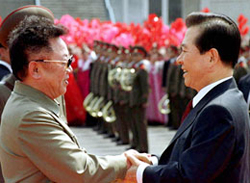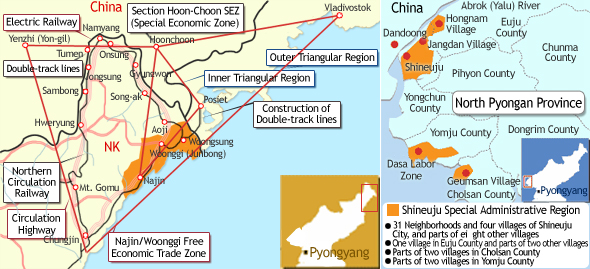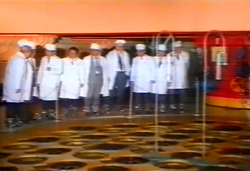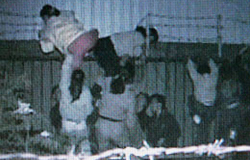|
|
|
 North Korea in the 21st Century - At the Crossroads
of Nuclear Armament or Open Reform
North Korea in the 21st Century - At the Crossroads
of Nuclear Armament or Open Reform |
|
Although the ‘grueling march’ has
been officially announced as being over, numerous
obstacles lie ahead of North Korea in the 21st century.
Its isolated economic structure can always spiral
down into another crisis. Furthermore, it is still
heavily reliant on foreign aid in meeting food demand,
suggesting that a change in foreign relations or
global food production could spark a new episode
of famine.
While Kim Jong-il retains full political authority,
many signs are visible that North Korea’s social
control mechanism has loosened. In addition, North
Korea has begun a high-stakes ‘game’ against the
U.S. and the international community by pursuing
a secret nuclear weapons program. |
|
| Improvements in North-South Relations |
| One notable characteristic of
North Korean foreign policy in the late-1990s
and 2000s is its active approach to diplomacy
with South Korea. This was reciprocated and amplified
by the ‘sunshine policy’ pursued by South Korea.
The 1998 visit to North Korea by Hyundai President
Jung Ju-young and his gift of 500 head of cattle,
as well as the inception of the Mt. Geumgang tour
program, changed the paradigm of North-South relations.
Also pursued was the Gaesong Industrial Complex
project, which involves building an industrial
complex in North Korea’s Gaesong region to combine
the South’s capital with the North’s land and
labor.
 |
| North
and South’s leaders meet for the first
time since the division of the Peninsula
- June 13, 2000 |
|
In the year 2000, President Kim Dae-jung paid
an open visit to Pyongyang and met with Kim Jong-il
to hold summit talks. The two leaders arrived
at the ‘6.15 Joint Statement’, comprising five
key principles :
△independent efforts for reunification,
△seeking out common ground in North-South views
on reunification,
△meetings of separated families, and resolving
the so-called ‘unconverted prisoners’ issue,
△active exchange and cooperation, and
△resuming North-South bilateral conversations.
Projects such as the meetings of separated families
and minister-level talks were discussed with enthusiasm,
while channels of conversation between military
and other authorities were opened. Also pursued
were projects to reconnect railways in the west
and east coast regions, as well as civilian-level
interaction in the form of a Joint North-South
Ceremony.
In addition, the participation of North Korean
athletes and supporters in the 2002 Busan Asian
Games further marked a significant improvement
in North-South relations. Meanwhile, with more
than a million South Koreans having visited Mt.
Geumgang over the past six years, the tours have
become a symbol of North-South relations. Fertilizer,
food, and medicine provided by South Korea became
an important factor in the North Korean economy,
and South Korea surpassed Japan to become North
Korea’s 2nd-largest trade partner after China.
The North Korean economy is becoming more and
more reliant on the South’s. |
|
| New Economic Initiatives and the Shineuiju SEZ (Special Economic Zone) |
The stability of Kim Jong-il’s
power did not translate into stability and growth
for the North Korean economy. Innate limitations
remained, while external factors worsened to further
isolate the economy. The three-year long buffer
period enacted in 1994 did not yield any significant
results. North Korea still relied on foreign aid
to meet domestic food demand, while relying heavily
on China and South Korea for trade. The lack of
capital, technology, and information made it difficult
for North Korea to achieve economic growth on
its own. The Shineuiju SEZ (Special Economic Zone)
was proposed as a means to overcome such difficulties.
This was not the first special economic zone pursued
by North Korea. A project to build a free trade
zone (FTZ) in Hamkyung Province’s Najin port and
Sonbong region was implemented in 1991 with the
aim of transforming the zone into an international
cargo relay point, export manufacturing center,
as well as a tourist and financial hub. Despite
the legal and institutional efforts made, the
claustrophobic social atmosphere, inadequate infrastructure,
and shaky credibility resulted in the project’s
failure.
|
 |
The Shineuiju SEZ was fundamentally
different from the Najin-Sonbong FTZ. Kim Jong-il,
during a visit to China, witnessed the local reform
and opening-up that was underway. He reportedly
remarked that ‘a whole new world’ was being created
there. The Shineuiju SEZ is an ambitious project
that came at a time when the ‘buffer’ plan had
failed and the North Korean leadership had run
out ideas. The blueprint for the zone was announced
at a meeting of the SPA Permanent Committee on
September 12, 2002. The zone was to be a de facto
‘state within a state’ similar to Hong Kong, being
a ‘special administrative region’ with its own
Minister.
Business activity and private property rights
were to be fully observed. Located next to China
and the Yellow Sea, the zone is highly accessible
to foreigners and their capital. Amid international
fanfare, the Chinese businessman Yang Bin was
appointed as the zone’s first Minister. However,
the Shineuiju SEZ project ran into trouble when
Yang was arrested by China on corruption charges,
and has been mired in inactivity ever since. |
|
| The 7.1 Economic Reforms |
Although officially announced in
2002, the 7.1 economic reforms were enacted because
Kim Jong-il had given orders to improve the management
of the economy in October 2001. The reforms aimed
to identify and correct flaws in economic management.
In an attempt to overcome the chronic lack of
supplies, prices and wages were adjusted according
to the market-based system of supply and demand.
The adjustment caused the prices of some items
to jump several hundred-fold and wages to rise
20-fold. The authorization of ‘farmers’ markets’
enabled individuals to engage in commercial activity.
The reforms introduced a basic and strictly restricted
form of market economy. Farmers’ markets in some
regions evolved into larger-scale markets where
transaction of virtually all kinds of goods took
place. Factories, crafts shops, and farms now
had to manage their own revenues and costs. Although
still a socialist economy in principle, capitalist
elements are gradually taking root in North Korea. |
|
| The 2nd North Korea Nuclear Crisis |
| The Geneva Accord of 1994 had
put the North Korean nuclear weapons issue momentarily
on the back burner. However, suspicions of a nuclear
program in Kumchangri brought the issue to the
forefront again in the late 1990s. High-level
talks between North Korea and the U.S. led to
North Korea’s consent to a U.S.-led inspection.
Relations seemed to be in the process of recovery
following the October 2000 visit to the White
House by 1st Section Chief of the National Defense
Commission, Cho Myung-rok, and a reciprocal visit
to Pyongyang by Secretary of State Madeline Albright.
 |
| The
2nd North Korea nuclear crisis severely
altered South Kores-North Korea-US relations
following the 6.15 Joint Statement |
|
However, relations soon deteriorated with the
launch of the George W. Bush administration. The
U.S. constantly expressed doubt on North Korea’s
compliance with the Geneva Accord, while North
Korea denounced the U.S. for not providing light-water
reactors as stipulated by the agreement. A visit
to Pyongyang by a delegation led by Assistant
Secretary of State James Kelly in October 2002
led to North Korea’s admittance of its secret
nuclear program, bringing about the 2nd North
Korea nuclear crisis. North Korea proceeded to
scrap its official freeze on nuclear use, finally
withdrawing from the NPT in October 1, 2003. To
make matters worse, North Korea was suspected
of using HEU (highly-enriched uranium) as well
as plutonium to develop nuclear weapons.
North Korea was criticized for breaching the Geneva
Accord by secretly pursuing the development of
nuclear weapons even after the agreement was announced.
In response, North Korea complained that the U.S.
had strayed from the agreement as well, in that
it failed to provide the light-water reactors. |
|
| The Six-Party Talks |
| The 2nd North Korea nuclear crisis led
to a stalemate between North Korea and the U.S.
North Korea hoped to directly engage the U.S.,
requesting concessions and regime security assurances
in exchange for giving up its nuclear program.
Meanwhile, the U.S. was reluctant to negotiate
with North Korea, responding that there must be
‘no rewards for wrong actions’. A multilateral
framework of conversation between the U.S., the
two Koreas, China, Russia, and Japan was proposed
as a way around the stalemate. China was appointed
as the mediator state, and the 1st round of the
six-party talks was held in Beijing in July 2003.
After a 2nd and 3rd round of fruitless talks,
the six-party talks saw a more than one-year period
of inactivity before reconvening for a fourth
round in late July 2005. |
|
| Loosened Social Control in North Korea
|
 |
| North
Korea refugees climb the fence of a
foreign embassy in Beijing |
|
|
North Korea’s control over its society generally
loosened during the ‘grueling march’ years. A prime
example of this is the exodus of hungry North Koreans.
Most of the refugees fled to China due to the famine,
and those who were able headed for South Korea.
These so-called ‘economic refugees’ have become
a human rights issue in the international community.
Although not as full-blown in scale as the refugees
that fled the East European communist states upon
their collapse, a steady number of North Koreans
continue to flee their country. |
|
|
 |
|